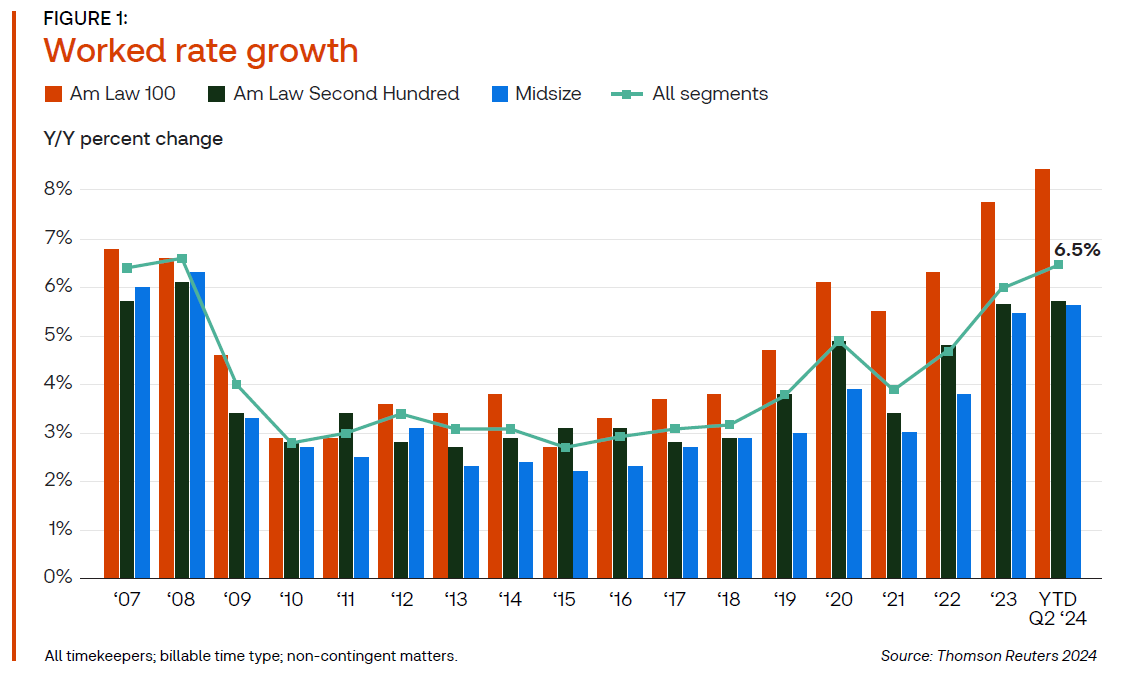Law firms are continuing their impressive run of growth in billing rates; however, potentially softer demand in 2025 may make such continued strong rate growth an important necessity
No observer of the legal market should be surprised to hear that law firm billing rates continue to be watched closely by both law firms and corporate law departments — each side, however, has their own reasons for this.
For law firms, growth in law firm rates has been one of, if not the key driver of the growth in firm profitability for the past decade, making the rates they charge tantamount to their profitability. Clients, on the other hand, are facing mounting pressure to control costs and dealing with increasing matter volumes and a largely flat headcount. That means, they potentially will have to rely more on outside counsel, making the rates they pay of critical importance.
Though the motivation for watching rate performance may differ, both sides readily agree that rates are a key indicator when evaluating the legal market economy.
Partnering once again with the True Value Partnering Institute, the Thomson Reuters Institute’s Law firm rates in 2024 report explores how rate performance so far in 2024 has doubled-down on the long-term trend of strong rate growth on a year-over-year basis. However, this year has also seen the continuation of a relatively recent phenomenon of steadily increasing rate growth throughout the year.
However, there are signals that clients may be starting to push back more actively on rates, leading to increasing questions about how long this surge in rates will be sustainable. Yet, law firms should not necessarily rush to restrain rate growth in places where the market is willing to tolerate it, but rather just be aware of clients’ sentiment.
Through the mid-year point of 2024, a years-long trend of steadily increasing growth in worked rates, also known as agreed rates, has continued, with no real signs of slowing. Through the mid-year point, worked rates grew by an average of 6.5% compared to the time last year.

Broad growth with support from practice demand
The report shows that acceleration in rate growth is remarkable not only for its height but also its breadth, with all major law firm segments reaching new heights in rate growth. Am Law 100 law firms, for example, continue to lead the market with growth in worked rates of 8.4% year-to-date (YTD), but both Am Law Second Hundred and Midsize law firms have similarly been aggressive in their growth for the past two years as well. The most recent quarterly results found Am Law Second Hundred and Midsize law firms at 5.9% and 5.6% growth in worked rates, respectively.
As recently as 2022, both of these segments had constrained their rate growth below 5%. However, both Am Law Second Hundred and Midsize law firms seem to have taken note of the aggressive pace of rate growth pushed by their larger Am Law 100 counterparts and seem to be willing to strike while the iron is hot.
Further boosting profitability for law firms thus far in 2024 has been the coupling of rate growth with impressive growth in demand, from counter-cyclical practices like litigation as well as a resurgence in general corporate demand.
How long can it last?
As the report discusses, however, that extra boost for profitability may not be reliable in the long term. Current indications for the direction of the overall economy indicate that law firms may need to continue to look to rates as their primary profitability driver as they move into 2025. Continued high interest rates, downward revisions to US jobs numbers, a troubling real estate market, and the upcoming US presidential election are all contributing to the uncertainty that many people feel about how the economy will emerge in 2025.
This economic uncertainty paints a potentially foreboding picture for transactional practices into next year, meaning a potentially gloomy legal demand outlook overall. Without the benefit of additional working hours, firms will once again rely on their rate structures to provide the basis for increased revenue and, ultimately, profit.
Indeed, we are seeing early signs that the pace of rate growth seen for the last few years across the globe may already be slowing, as indications from regions such as Australia demonstrate a potentially cooler rates environment there. Should those early indications prove to be the vanguard of a trend, law firms may well find themselves pivoting in 2025 toward strategies that emphasize not only getting the most out of rate increases through negotiations, but also capturing as much of those increases as possible through aggressively pursuing collections.
For more in-depth analysis of law firm rates in 2024 and what the future may hold, you can download a copy of the full “Law firm rates in 2024” report by filling out the form below:







